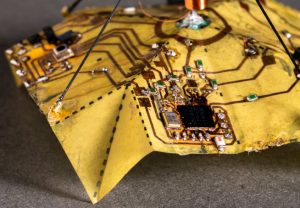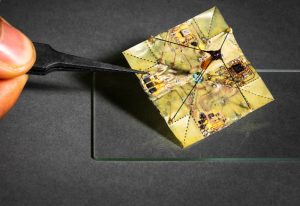Dropped in clusters, they spread out until commanded to fall straight.
“They use an origami fold to switch from tumbling through the air to dropping straight to the ground,” according to the university. “To spread out the fliers, the researchers control the timing of each device’s transition using an on-board pressure sensor estimating altitude, an on-board timer or a Bluetooth signal.”
Weighing ~400mg, each flyer (Ed: faller?) has an actuator, a solar cell and a controller, as well as carrying sensors for temperature and humidity alongside the altitude sensor – with all circuits built directly on the flyers structure.

They are mechanically bi-stable and, at the moment, can only switch from chaotic (dispersing) to stable (falling straight) states on command, which can be initiated by the actuator in ~25ms. Hysteresis is sufficiently strong to prevent accidental transition when falling.
Electronics Weekly has requested more information, so watch this space
Future devices will be able to transition in both directions for more precise landings in turbulent wind conditions, according to the team.
“Using origami opens up a new design space for microfliers,” said Washington researcher Vikram Iyer. “We combine the Miura-ori fold, which is inspired by geometric patterns found in leaves, with power harvesting and tiny actuators to allow our fliers to mimic the flight of different leaf types in mid-air. In its unfolded flat state, our structure tumbles chaotically similar to an elm leaf. Switching to the folded state enables a stable descent similarly to how a maple leaf falls.”
The work is published as ‘Solar-powered shape-changing origami microfliers‘ in Science Robotics (payment necessary for full access).
Image credit: Mark Stone University of Washington

